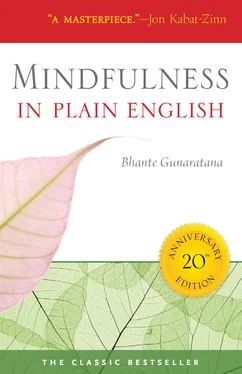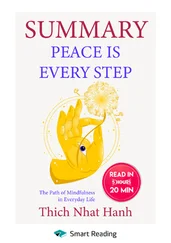Henepola Gunaratana - Mindfulness in Plain English
Здесь есть возможность читать онлайн «Henepola Gunaratana - Mindfulness in Plain English» весь текст электронной книги совершенно бесплатно (целиком полную версию без сокращений). В некоторых случаях можно слушать аудио, скачать через торрент в формате fb2 и присутствует краткое содержание. Жанр: Самосовершенствование, на английском языке. Описание произведения, (предисловие) а так же отзывы посетителей доступны на портале библиотеки ЛибКат.
- Название:Mindfulness in Plain English
- Автор:
- Жанр:
- Год:неизвестен
- ISBN:нет данных
- Рейтинг книги:3 / 5. Голосов: 1
-
Избранное:Добавить в избранное
- Отзывы:
-
Ваша оценка:
- 60
- 1
- 2
- 3
- 4
- 5
Mindfulness in Plain English: краткое содержание, описание и аннотация
Предлагаем к чтению аннотацию, описание, краткое содержание или предисловие (зависит от того, что написал сам автор книги «Mindfulness in Plain English»). Если вы не нашли необходимую информацию о книге — напишите в комментариях, мы постараемся отыскать её.
Mindfulness in Plain English — читать онлайн бесплатно полную книгу (весь текст) целиком
Ниже представлен текст книги, разбитый по страницам. Система сохранения места последней прочитанной страницы, позволяет с удобством читать онлайн бесплатно книгу «Mindfulness in Plain English», без необходимости каждый раз заново искать на чём Вы остановились. Поставьте закладку, и сможете в любой момент перейти на страницу, на которой закончили чтение.
Интервал:
Закладка:
Mindfulness is a function that disarms distractions, in the same way that amunitions expert might defuse a bomb. Weak distractions are disarmed by a single glance. Shine the light of awareness on them and they evaporate instantly, never to return. Deep-seated, habitual thought patterns require constant mindfulness repeatedly applied over whatever time period it takes to break their hold. Distractions are really paper tigers. They have no power of their own. They need to be fed constantly, or else they die. If you refuse to feed them by your own fear, anger, and greed, they fade.
Mindfulness is the most important aspect of meditation. It is the primary thing that you are trying to cultivate. So there is really no need at all to struggle against distractions. The crucial thing is to be mindful of what is occurring, not to control what is occurring. Remember, concentration is a tool. It is secondary to bare attention. From the point of view of mindfulness, there is really no such thing as a distraction. Whatever arises in the mind is viewed as just one more opportunity to cultivate mindfulness. Breath, remember, is an arbitrary focus, and it is used as our primary object of attention. Distractions are used as secondary objects of attention. They are certainly as much a part of reality as breath. It actually makes rather little difference what the object of mindfulness is. You can be mindful of the breath, or you can be mindful of the distraction. You can be mindful of the fact that you mind is still, and your concentration is strong, or you can be mindful of the fact that your concentration is in ribbons and your mind is in an absolute shambles. It’s all mindfulness. Just maintain that mindfulness and concentration eventually will follow.
The purpose of meditation is not to concentrate on the breath, without interruption, forever. That by itself would be a useless goal. The purpose of meditation is not to achieve a perfectly still and serene mind. Although a lovely state, it doesn’t lead to liberation by itself. The purpose of meditation is to achieve uninterrupted mindfulness. Mindfulness, and only mindfulness, produces Enlightenment.
Distractions come in all sizes, shapes and flavors. Buddhist philosophy has organized them into categories. One of them is the category of hindrances. They are called hindrances because they block your development of both components of mediation, mindfulness and concentration. A bit of caution on this term: The word ‘hindrances’ carries a negative connotation, and indeed these are states of mind we want to eradicate. That does not mean, however, that they are to be repressed, avoided or condemned.
Let’s use greed as an example. We wish to avoid prolonging any state of greed that arises, because a continuation of that state leads to bondage and sorrow. That does not mean we try to toss the thought out of the mind when it appears. We simply refuse to encourage it to stay. We let it come, and we let it go. When greed is first observed with bare attention, no value judgements are made. We simply stand back and watch it arise. The whole dynamic of greed from start to finish is simply observed in this way. We don’t help it, or hinder it, or interfere with it in the slightest. It stays as long as it stays. And we learn as much about it as we can while it is there. We watch what greed does. We watch how it troubles us, and how it burdens others. We notice how it keeps us perpetually unsatisfied, forever in a state of unfulfilled longing. From this first-hand experience, we ascertain at a gut level that greed is an unskillful way to run your life. There is nothing theoretical about this realization.
All of the hindrances are dealt with in the same way, and we will look at them here one by one.
Desire:Let us suppose you have been distracted by some nice experience in meditation. It could be pleasant fantasy or a thought of pride. It might be a feeling of self-esteem. It might be a thought of love or even the physical sensation of bliss that comes with the meditation experience itself. Whatever it is, what follows is the state of desire—desire to obtain whatever you have been thinking about or desire to prolong the experience you are having. No matter what its nature, you should handle desire in the following manner. Notice the thought or sensation as it arises. Notice the mental state of desire which accompanies it as a separate thing. Notice the exact extent or degree of that desire. Then notice how long it lasts and when it finally disappears. When you have done that, return your attention to breathing.
Aversion:Suppose that you have been distracted by some negative experience. It could be something you fear or some nagging worry. It might be guilt or depression or pain. Whatever the actual substance of the thought or sensation, you find yourself rejecting or repressing—trying to avoid it, resist it or deny it. The handling here is essentially the same. Watch the arising of the thought or sensation. Notice the state of rejection that comes with it. Gauge the extent or degree of that rejection. See how long it lasts and when it fades away. Then return your attention to your breath.
Lethargy:Lethargy comes in various grades and intensities, ranging from slight drowsiness to total torpor. We are talking about a mental state here, not a physical one. Sleepiness or physical fatigue is something quite different and, in the Buddhist system of classification, it would be categorized as a physical feeling. Mental lethargy is closely related to aversion in that it is one of the mind’s clever little ways of avoiding those issues it finds unpleasant. Lethargy is a sort of turn-off of the mental apparatus, a dulling of sensory and cognitive acuity. It is an enforced stupidity pretending to be sleep. This can be a tough one to deal with, because its presence is directly contrary to the employment of mindfulness. Lethargy is nearly the reverse of mindfulness. Nevertheless, mindfulness is the cure for this hindrance, too, and the handling is the same. Note the state of drowsiness when it arises, and note its extent or degree. Note when it arises, how long it lasts, and when it passes away. The only thing special here is the importance of catching the phenomenon early. You have got to get it right at its conception and apply liberal doses of pure awareness right away. If you let it get a start, its growth probably will outpace your mindfulness power. When lethargy wins, the result is the sinking mind and/or sleep.
Agitation:States of restlessness and worry are expressions of mental agitation. Your mind keeps darting around, refusing to settle on any one thing. You may keep running over and over the same issues. But even here an unsettled feeling is the predominant component. The mind refuses to settle anywhere. It jumps around constantly. The cure for this condition is the same basic sequence. Restlessness imparts a certain feeling to consciousness. You might call it a flavor or texture. Whatever you call it, that unsettled feeling is there as a definable characteristic. Look for it. Once you have spotted it, note how much of it is present. Note when it arises. Watch how long it lasts, and see when it fades away. Then return your attention to the breath.
Doubt:Doubt has its own distinct feeling in consciousness. The Pali tests describe it very nicely. It’s the feeling of a man stumbling through a desert and arriving at an unmarked crossroad. Which road should he take? There is no way to tell. So he just stands there vacillating. One of the common forms this takes in meditation is an inner dialogue something like this: “What am I doing just sitting like this? Am I really getting anything out of this at all? Oh! Sure I am. This is good for me. The book said so. No, that is crazy. This is a waste of time. No, I won’t give up. I said I was going to do this, and I am going to do it. Or am I being just stubborn? I don’t know. I just don’t know.” Don’t get stuck in this trap. It is just another hindrance. Another of the mind’s little smoke screens to keep you from doing the most terrible thing in the world: actually becoming aware of what is happening. To handle doubt, simply become aware of this mental state of wavering as an object of inspection. Don’t be trapped in it. Back out of it and look at it. See how strong it is. See when it comes and how long it lasts. Then watch it fade away, and go back to the breathing.
Читать дальшеИнтервал:
Закладка:
Похожие книги на «Mindfulness in Plain English»
Представляем Вашему вниманию похожие книги на «Mindfulness in Plain English» списком для выбора. Мы отобрали схожую по названию и смыслу литературу в надежде предоставить читателям больше вариантов отыскать новые, интересные, ещё непрочитанные произведения.
Обсуждение, отзывы о книге «Mindfulness in Plain English» и просто собственные мнения читателей. Оставьте ваши комментарии, напишите, что Вы думаете о произведении, его смысле или главных героях. Укажите что конкретно понравилось, а что нет, и почему Вы так считаете.












